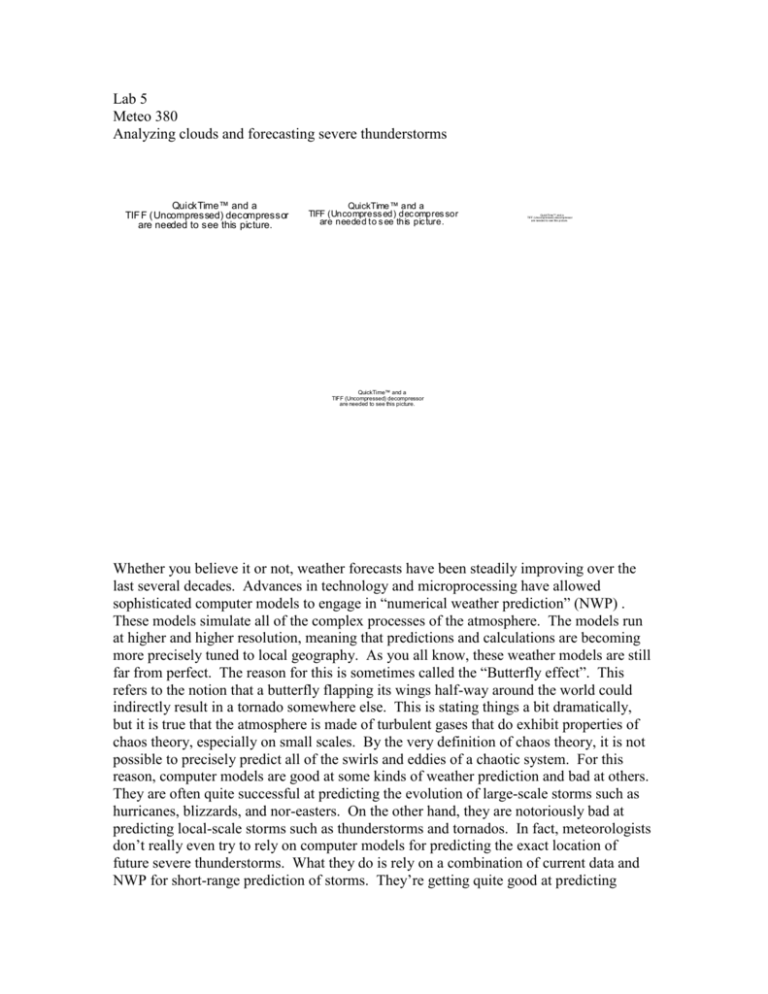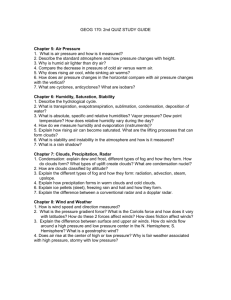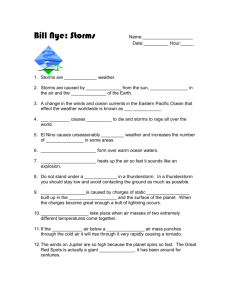Lab 1
advertisement

Lab 5 Meteo 380 Analyzing clouds and forecasting severe thunderstorms QuickTime™ and a TIF F (Uncompressed) decompressor are needed to see this picture. QuickTime™ and a TIFF (Uncompress ed) dec ompres sor are needed to s ee this pic ture. QuickTime™ and a TIFF (Uncompressed) decompressor are needed to see this picture. QuickTime™ and a TIFF (Uncompressed) decompressor are needed to see this picture. Whether you believe it or not, weather forecasts have been steadily improving over the last several decades. Advances in technology and microprocessing have allowed sophisticated computer models to engage in “numerical weather prediction” (NWP) . These models simulate all of the complex processes of the atmosphere. The models run at higher and higher resolution, meaning that predictions and calculations are becoming more precisely tuned to local geography. As you all know, these weather models are still far from perfect. The reason for this is sometimes called the “Butterfly effect”. This refers to the notion that a butterfly flapping its wings half-way around the world could indirectly result in a tornado somewhere else. This is stating things a bit dramatically, but it is true that the atmosphere is made of turbulent gases that do exhibit properties of chaos theory, especially on small scales. By the very definition of chaos theory, it is not possible to precisely predict all of the swirls and eddies of a chaotic system. For this reason, computer models are good at some kinds of weather prediction and bad at others. They are often quite successful at predicting the evolution of large-scale storms such as hurricanes, blizzards, and nor-easters. On the other hand, they are notoriously bad at predicting local-scale storms such as thunderstorms and tornados. In fact, meteorologists don’t really even try to rely on computer models for predicting the exact location of future severe thunderstorms. What they do is rely on a combination of current data and NWP for short-range prediction of storms. They’re getting quite good at predicting exactly where severe weather is imminent in the next hour (within a few miles) or approximately where it is likely within the next two days (within a 20-30 miles). When these forecasts are successful, they can save lives and property. Today, were going to put ourselves in the shoes of expert forecasters at National Weather Service’s Storm Prediction Center. Your job is to start by examining the clouds in the local area and to continue by looking at the most sophisticated current meteorological observations and computer model forecasts to determine the imminent severe storm risk across the country and the risk for the rest of the day. I will help guide you through this lab, but much of the lab is meant to encourage you to use your creativity and to explore high-quality web resources. 1. Cloud analysis: Radiosonde data and surface observations A good start in thinking about severe weather is to think about and analyze the clouds that are present and the clouds that may form in the near future. Let’s do this analysis specifically for the Boston area. Tools: A. Your eyes…you can look up at the sky and observe the clouds yourself B. Surface observations of clouds from local observers: Local weather observers at airports report cloud types and cloud base heights based on reports from pilots and laser techniques. Check out the following resource: http://adds.aviationweather.gov/metars/ (type in @MA to get reports from all Massachusetts sites) C. Radiosondes: A radiosonde is an instrument attached to a weather balloon that measures the temperature and wind structure of the upper atmosphere as it floats skyward. These are launched from about 100 places across the country several times a day. This temperature structure with height can reveal a great deal about the risk for different types of severe weather. In general, the colder it is at high altitude, the more vigorously storm clouds will form. Ask for some help in interpreting this complex and highly valuable set of measurements. Analysis Questions to answer: 1. What type of clouds are outside right now? What fraction of the sky do they cover? Are they increasing or decreasing 2. What height(s) are these clouds located? Indicate an estimate in thousands of feet based on items B and C above. 3. What is the maximum depth and height for any convection today? 4. What is the height of the freezing level today? Are there any clouds above this layer? 2. NOW-casting: Where are storms happening right now and where are they headed? NOW-casting is a technique that has emerged over recent years with the development of remote sensing instruments such as radar and satellite. Use the following set of tools and imagery to try to answer the following questions. For help interpreting imagery, please ask! Tools: A. Satellite (VIS and IR): Satellite images are really just digital pictures taken from space. These pictures can provide a lot of information about clouds. Visible satellite pictures are just black and white images that show cloud tops. Cloud tops of severe thunderstorms have a distinctive “bubbly” appearance on visible satellite pictures. See if you can find any of these. Infrared satellite photos actually detect the temperature of the top of the clouds. A very high, thick cloud will be very cold, often indicates a severe thunderstorm; these cold cloud tops are shown by bright orange or red colors in IR satellite imagery. VIS: IR: http://www.meteo.psu.edu/~gadomski/SAT_US/recentvis.html http://www.meteo.psu.edu/~gadomski/SAT_US/recentir.html B. Lightning (recently measured lightning strikes): High-resolution measurement of lightning location is not made by the US government, but rather by private industry. For this reason, good data is not free. However, low-resolution data is available and provides a good picture of where thunderstorms are currently occurring across the country. Of course, not all thunderstorms are severe, but those with intense lightning frequently are. http://www.hazardpredictor.com/ltg/images/uspln.jpg C. Radar Reflectivity (intensity of precipitation): Radar is perhaps the most familiar remote sensing tool to the average citizen. It is a key component to any weather forecast because it is a perfect indication of the intensity of ongoing precipitation. The most common radar image shows the intensity of electromagnetic radiation which is reflected to the radar station by raindrops or hail. This “reflectivity” is most dependent on the size of the largest drops. Severe storms have strong updrafts, which support the growth of big raindrops and hailstones. It turns out that reflectivities greater that 55 dB (usually bright red or pink) indicate a severe storm. http://radar.weather.gov/ridge/Conus/full.php D. Doppler Velocity (intensity of winds and tornadic indication): The “Doppler” part of Doppler radar is all about the indication of wind speeds toward and away from the radar. These plots can be tricky to interpret, because the data does not show true wind speed or direction. However, just before and during a tornado, it shows up on the dopper velocity as a “couplet” of winds, where adjacent pixels show strong winds in opposite directions. http://www.rap.ucar.edu/weather/radar/ (click on .5 velocity) E. Recent Storm Reports: Take a look at where severe weather has already been reported today. Chances are that the same system of storms will produce similar types of damage. Geographic patterns of damage can indicate where severe storms are headed. http://www.spc.noaa.gov/climo/ Analysis Questions to Answer: 1. Are there any severe storms right now in the country? How do you know that they are severe? Where are they? 2. What direction are they moving, what speed? 3. Would you issue any severe storm warnings for the next half hour? What would you warn about? Write that warning for the appropriate counties. 3. Short-Term Forecasting: where are severe storms likely this afternoon? The inherent daily cycle of solar heating usually causes the greatest instability and storm severity during late afternoon and evening. Where in the US are severe storms most likely later today? Is the risk of hail or tornados high? If so, where? These questions can be answered by a combination of short-term forecast tools which include our NOW-cast results, weather-balloon observations, and computer models. Interpreting the meaning of some of these tools can be tricky, so be sure to ask for assistance! While we can’t say which house will be struck, we can say which states are at risk and how high that risk is. Tools: A. Radiosondes: A radiosonde is an instrument attached to a weather balloon that measures the temperature and wind structure of the upper atmosphere as it floats skyward. These are launched from about 100 places across the country several times a day. This temperature structure with height can reveal a great deal about the risk for different types of severe weather. In general, the colder it is at high altitude, the more vigorously storm clouds will form. Ask for some help in interpreting this complex and highly valuable set of measurements. http://www.rap.ucar.edu/weather/upper/ http://www.spc.noaa.gov/exper/soundings/ B. Moisture: As a general rule, severe storms are not likely where there is little moisture available. Where is the air most moist? http://coolwx.com/cgi-bin/getanalysis.php?region=us&time=current&field=dewp C. Bouyancy: Storm clouds must rise vertically in vigorous fashion in order to become severe. For this to happen, “instability” must be present. This refers to the notion that air from the surface would be warmer and less dense than the background atmosphere at most heights. Warmer “pockets” of air are less dense and rise buoyantly like hot-air balloons. The bigger this temperature difference, the larger the updrafts that can develop. One way to measure this is through a thermodynamic statistic of the energy that is available to cause updrafts. This is an important forecast tool called CAPE (Convective Available Potential Energy) and is calculated for the next two days by computer models of the atmosphere. The present amount of CAPE can also be measure directly from the radiosondes. http://weather.unisys.com/nam/misc/nam_cape_4panel.html D. Wind Shear: The characteristics of wind speeds and directions at high altitudes plays a major role in the development of severe storms and especially tornados. Tornados are likely when strong winds blow at different directions at different altitudes. This is called wind shear, and is a large part of what leads to swirling columns of air. For somewhat complex reasons, wind shear also helps to promote strong updrafts and supercell storms. http://www.spc.noaa.gov/exper/mesoanalysis/s4/index2.html (click on wind shear and Eff. Shear 0-6 km) E. Lifting Mechanisms: Instability and wind shear is not the whole story when it comes to severe weather. Many times, a triggering mechanism is needed to “kick-start” the pockets of air and give them an upward push into the region of instability. These mechanism include cold-fronts, sea-breeze convergences, mountains, and just plain hot sunshine. http://weather.unisys.com/surface/sfc_map.html F. Composite Indices: These computer-model statistics combine the above information is specific ways to calculate specific risks. There are statistics that combine information to assess risk of any kind of severe weather, damaging winds, hail, and tornados http://www.spc.noaa.gov/exper/mesoanalysis/s4/index2.html (click on composite indices and examine the various choices) Analysis Questions to Answer: 1. Where in the country do you predict the highest likelihood for severe thunderstorms this evening? What information is this based on? 2. Is there an especially strong chance for high winds, hail, or tornados? Where is each threat greatest? 3. When you have answered the questions above, examine the national convective forecast made by the experts at the National Severe Storms Laboratory. Can you follow their reasoning? Have they missed anything that you observed? http://www.spc.noaa.gov/products/outlook/day1otlk.html








